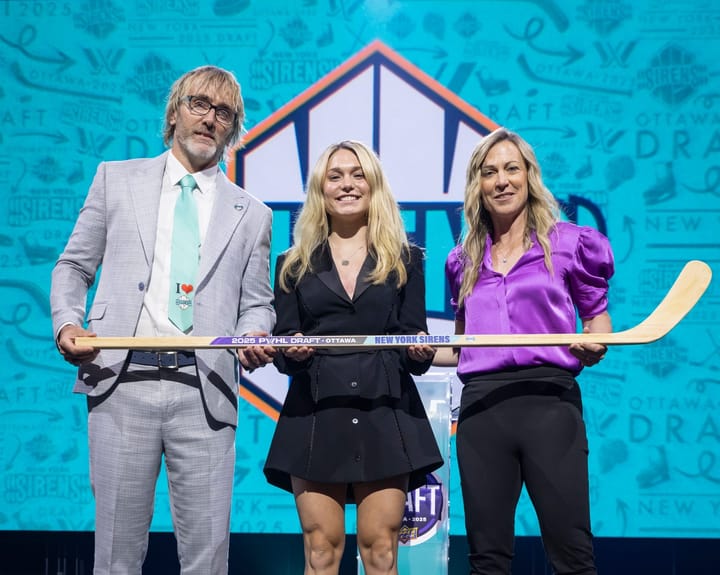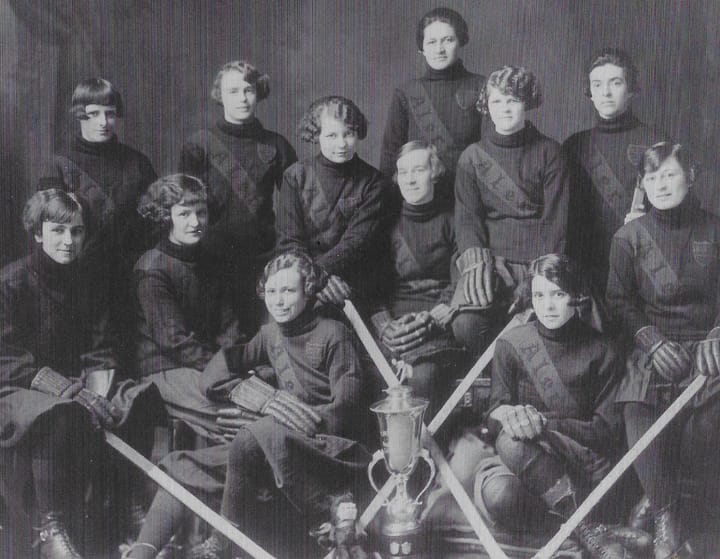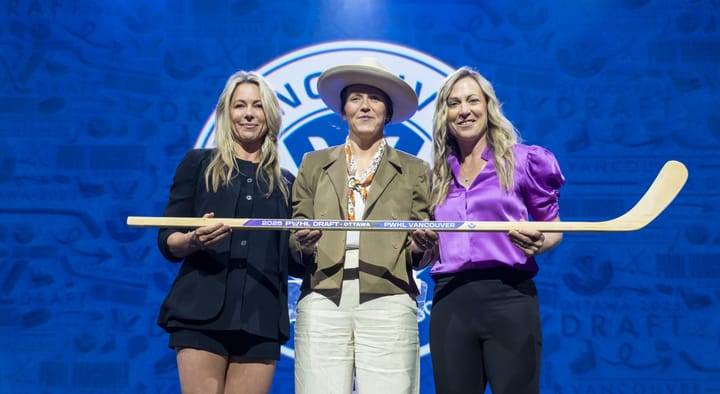Looking back at the 2017 CWHL Draft
Joe Pack makes some observations about the 2017 draft and what it could mean for the season ahead.
Draft day for any league is a day for hope and promise. In many ways, the CWHL Draft accomplished just that with new beginnings for draftees, opportunities for players from nine different countries, and the finalization of the two Chinese rosters set to join the league in an unprecedented expansion of women’s hockey around the world.
But the day was marred if you weren’t a player, staff member, or parent. CWHL commissioner Brenda Andress did not make herself available to the media after a rocky summer that included a bungled announcement of the second Chinese team -- in a tweet, with no accompanying press release, that was soon deleted -- and dozens of unanswered questions about how the changes borne out of expansion will affect players.
Thanks to @DRdiabloTHW we've got a screenshot of the Tweet. So, it's still out there. pic.twitter.com/L4qlUSIkkC
— The Ice Garden (@TheIceGarden) July 17, 2017
The addition of two CWHL teams in China is a remarkable development and a potential surge in the growth in women’s hockey but the media engagement from the league has been puzzling (though some of that can be attributed to the lack of a communications director for most of this summer) and the story has been muted, in part also due to lack of regular coverage of women’s hockey in North America.
How will growth in the sport be measured, and whose growth exactly? Expansion should be a good thing, and hopefully it is for all involved.
News and notes:
1. I can only wonder why Brenda Andress did not address the media at the draft. This is not an attempt to write a story about the media and how it was wronged. It’s a two-foot putt to appear on draft day as the commissioner and engage with the people who can more broadly get your message out to fans and. It’s a good news day, dreams are coming true, the CWHL is expanding and growing women’s hockey. Saying nothing is a mystery and looks like avoidance.
The story of the day, from my point of view, was the big questions that remain unanswered by the CWHL’s commissioner -- and I wish that wasn’t so. How much money have the Chinese teams invested in the league? Does that affect how and when CWHLers are paid? What will the schedule look like and how will the league accommodate players with full-time jobs traveling to China? This is the last year of the Sportsnet television deal; will it be renewed or expanded upon? How is the CWHL and Hockey China in step with one another regarding growth in women’s hockey? Why was the second team revealed months after the first?
The league instead offered to accept questions via email which I’ve sent along. I’ve had no response as of August 22 but will update.
Without any significant engagement with the league, I’m left stunned. The whole day was strange from the online media’s perspective (two small camera crews with CCTV and OMNI were also in attendance.) When I say online media, I mean myself, The Ice Garden’s Hannah Bevis, and Jonathan of Pension Plan Puppets. Just three writers were there on a day when the commissioner and all the league’s GMs are in the same room, and availabilities were hard to come by.
It's been a little tough for @Hannah_Bevis1 and I hearing the draft picks from outside the draft room where we're stationed 😐
— Joe Pack (@JoePack) August 20, 2017
The media in attendance was not substantial and yet experienced a cool relationship with the league’s communications staff. What’s behind this decision is another question I now have.
2. The Rays and Red Star want to win but the Clarkson Cup is not necessarily their end goal. We know that China is hosting the 2022 Winter Olympics and wish to medal in ice hockey, and joining the CWHL is part of its development plan. But how interested are they in the growth of the CWHL or the Clarkson Cup itself?
“Vanke wants to win and Kunlun wants to win [the Clarkson Cup],” said Vanke Rays coach Rob Morgan. “But at the end of the day, we’re there to build hockey in China.”
KRS GM Chris Vanstone differed slightly in his comments. “The goal is to win. We want to win a national championship or at least a league championship. Also, growing the game in China. You can’t do one or the other, it has to be both.”
There will be many roads in the growth of women’s hockey but if I’m a player in the CWHL, I’m asking why KRS and Vanke are able to pay its players as hockey ambassadors and disrupt my day job with travel when we possibly have different end goals.
3. Where else in sports will you see two teams in the same league working as closely in tandem as the Kunlun Red Star and Vanke Rays? The two GMs announced last week are Chris Vanstone, who has over a decade of experience in managing, coaching, and scouting, and Shirley Hon, an administrator with the men’s Kunlun Red Star of the KHL last year. Their opposite resumes suggest they’ll be helping each other from their positions of strength. But is that a conflict of interest?
“Although we’re competing against each other, [Vanstone and Hon] are going to learn from each other,” said Morgan. “It’s quite possible that the two teams play a similar game so that when we bring China together, the players can transition seamlessly.” That sounds great for China at the Olympics but seems to sap competitiveness from league play.
“I can help [Hon] out on the hockey side of things but having both teams travel and train together is going to be great,” said Vanstone.
4. KRS and Vanke will essentially be travel teams that scour North America together, and they seem to have dictated terms of the schedule. Though the schedule has not been released, the travel demands on the Chinese teams will be greater than that of the North American teams’ and there were hints that that was taken into account.
“We were lucky enough to set up our own schedule for when we wanted to fly in and out to keep the players as acclimated to time changes as possible,” said Vanstone. “The CWHL was very good in helping us with that.”
“There’s a lot of points being earned at hotels,” said Morgan.
5. Vanke will apparently soon announce the hiring of a Finnish goalie coach. Morgan said as much in his interview and it makes sense with Noora Raty in goal.
Goaltending is going to be crucial for the two Chinese teams (Elaine Chuli will backstop Vanke with Noora Räty playing for Kunlun.) Hockey Canada illustrated this summer how seriously they’re taking goaltending, hosting a goalie camp in Spain to train netminders from less traditional markets and in turn creating better parity in women’s hockey.
“When you have Noora Räty and Elaine Chuli coming in, with their backgrounds, they’re going to be unbelievable mentors,” said Morgan. “[The Chinese national players] will be exposed to better preparation, how to fuel their bodies, how to get the right amount of sleep, and how to carry themselves as elite athletes.”
6. Maybe the most pertinent information we got out of speaking with Rob is that over in China, they’re apparently calling him “carrot” since Robert translates as such (in which of the Chinese languages, I don’t know.)
7. Where in the world is Digit Murphy? The coach of the Kunlun Red Star and Chinese national women’s team was absent at the draft on Sunday, though other staff from the league's two Chinese teams were in attendance. A pillar in women’s hockey and former CWHL Clarkson Cup champion and coach of the year, Murphy would be a great ambassador for the league and her voice is missed at times like these.
So why wasn't she at the draft? I can only guess. Her departure from the CWHL in 2015, though, was less than ceremonious and even the details there are thin.
8. Teams tried to fill larger than normal gaps in depth that are due to Olympic centralization and all seemed to address those appropriately. Pension Plan Puppets has a good writeup of how the GTA teams did and Eyes on the Prize recapped who Les Canadiennes selected. Markham stocked up on defense and experience while Toronto addressed needs at the forward position. Calgary lost Emerance Maschmeyer to a trade with Montreal and in turn drafted standout goaltender Lindsey Post, who won a U Sports national championship and MVP award this past season.
Markham GM Chelsea Purcell said she expects draftee and veteran Lindsay Grigg to step in for Olympians Jocelyne Larocque and Laura Fortino and become the Thunder’s number-one defender.
9. Draftees came from as far as Turkey, Kazakhstan, Russia, and New Zealand in a year that yet again broke the record for most CWHL draft-eligible players (113 - 105 of which were selected.) Boston waded into international waters by taking Refika Yilmaz of Turkey and Bulbul Karatnbayeva of Kazakhstan while Markham selected Anna Goulding of New Zealand.
Purcell discussed the road Goulding is on and her chances at making the roster.
“I know that she’s a very hard worker. She’s a smaller player on defense so there will be quite a transition for her but she may be able to crack our lineup. We drafted eight (defenders) today so that will be tough trying to earn a position. But maybe she would fit better in the CWHL as a forward.”
Kartanbayeva’s story is a lot of fun. She says she learned of the draft months ago when a contingent of Hockey Canada (that included Sami Jo Small) visited Kazakhstan to host a hockey camp.
I asked Small about this and she gave the full back story. Her and Bridges were offered a role in events celebrating Canada’s 150th birthday in Kazakhstan, including Small participating in a Canada/Kazakhstan fundraising game (“I was disappointed no other women were playing in the game but hopefully next year they will be included,” said Small.) She ran a practice for the local women’s team in Astana, of which Karatanbayeva was the captain. “The girls presented me with a jersey from their club team (one of the coolest logos I’ve seen) and I showed them the Olympic gold medal.”
Such a fun skate with the Kazakhstan's Astana Women's Club team. Club hockey alive and strong. @CanEmbKZ @womenofkz pic.twitter.com/fYvKQKX0B2
— Sami Jo Small (@SamiJoSmall) May 29, 2017
Small advised Karatanbayeva to sign up for the draft and at least come to camp, reasoning that her chances at making a roster were better in an Olympic year.
“I thought she’d end up in the GTA but I believe she has family friends in the Boston area so that was a better fit. Bulbul is a great person, humble, and just really wants to improve her skills to help Kazakhstan make the Olympics. She was a smaller, speedy player who has great hands in small spaces. She was a leader among the players.
“I feel bad that she will be leaving Astana but I wish her all the best and hope she enjoys Boston.”
Her Twitter page is mostly trick-shot highlights and it’s pretty awesome. She wears number 99 and admitted on Twitter that she chose it because of “the Wayne.”
10. Toronto still needs a head coach and Sami Jo Small is totally not not a candidate. A league co-founder and decorated international goaltender, Small was involved with the Toronto Furies last season though she had recently given birth to a daughter. She attended the draft Sunday but was also at the Mastercard Centre with her husband Billy Bridges, a two-time Paralympic champion with Canada in sledge hockey, who was on the ice that day. I have no solid info telling me this is a possibility, so it’s just fun speculation.
And on that note, Kori Cheverie -- a former Furies forward -- made history last season as the first female coach in U Sports men’s hockey history when she joined the Ryerson Rams. Her and the staff led the team to first place in their division. Is there a role for her with the Furies in the future?
11. Will the Vanke Rays and Kunlun Red Star be competitive this year? With Olympic- and near-Olympic-calibre players like Räty and Kelli Stack, one has to consider that they could be. But how will the gaps between them be filled and how developed are the Chinese national players?
“Our first three lines are going to be as good as any team’s,” said Morgan. “China’s got three defenders that are as good as any, two more that will eventually get there, and the rest...they have some work to do.”
“Our staff did a great job of recruiting and evaluating talent in trying to find exactly what would work best for an expansion team," said Vanstone.
12. Just take a moment to appreciate this women’s hockey pinball game from the lobby of the Hockey Hall of Fame Resource Centre where the draft took place.
This women's hockey pinball machine is flippin rad pic.twitter.com/C3UUMspgUS
— Joe Pack (@JoePack) August 20, 2017
Anyone who has any insight into the background of that piece, I’d love to hear about it.
13. What motivated players to sign in China, outside of the paycheck?
Morgan: “Once word got out that there were going to be professional teams in China, we had players calling.” (It’s my understanding that upwards of 10-15 players were turned away after positions were spoken for.) “It’s a cultural experience that’s about more than just hockey. They’re a part of history, they’re growing the game. Not too many people will be able to say, ‘I helped grow hockey in China.’ Can you imagine if China were to medal in 2022?”
Digit Murphy's belief, not a prediction: China's women's hockey will medal in 2022.
— Joe Pack (@JoePack) June 6, 2017
“We have players [both Chinese national players and otherwise] on both teams that aspire to play in the 2022 Olympics. The training and facilities and coaching that’s going to be available to them is going to help them there.”
A sneak peek inside the athletes village... The 3 day countdown has begun! #KunlunRedStar #VankeRays pic.twitter.com/6PKUAnHTCn
— Steph Klein (@skleiner1) August 20, 2017
For players like Stack and Shiann Darkangelo, who were left off the American roster for 2018, this is likely a big reason for them to get on board.
14. Are the CWHL players on the five North American teams ready to act if their concerns and questions aren’t addressed? The CWHLPA has reached out to me to discuss concerns such as player compensation and fairness between China/North America, travel to China and its effect on their careers outside of hockey, and how Chinese investment will improve conditions for everyone, but will wait to comment until the league says something first.
After a month, still more questions than answers re expansion incl. on league fairness and player stipend amounts. Excited to know more soon
— CWHLPA (@CWHL_PA) July 25, 2017
I don’t believe we’ll see any strong action (such as refusing to play, attend camps) as it’s their last option. But not all are optimistic about the changes coming.





Comments ()